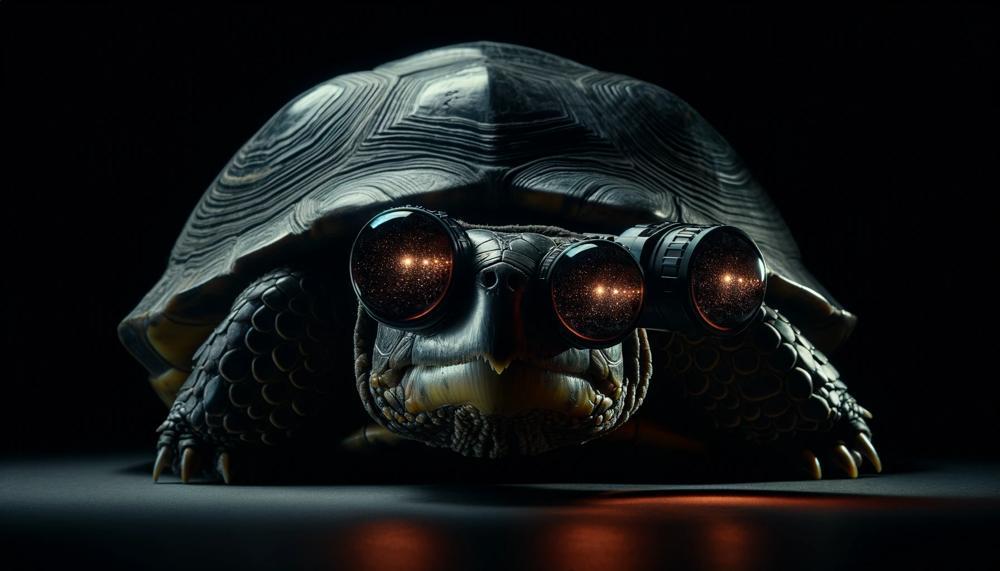Did you know that turtles, those ancient mariners of the world’s oceans and slow-paced wanderers of our lands, possess remarkable nocturnal abilities? Contrary to the common belief that turtles are mere diurnal creatures, recent research reveals their exceptional capacity to navigate and forage in low-light conditions. This insight not only broadens our understanding of these resilient reptiles but also sheds light on their survival strategies in diverse environments.
In this article, we will dive deep into the world of turtle vision, exploring how these creatures are adapted to see in the dark.
So, can turtles see in the dark?
Yes, turtles can see in the dark, but their vision is not as sharp as some nocturnal creatures. They do not possess true night vision. Turtles have eyes that are very similar and yet quite different from the human eye. They have adapted for many years to be able to see better in the dark.
While turtles don’t have laser sharp vision in the dark, they are able to maneuver around and see most objects around them. They do not possess the tapetum lucidum that dogs and cats possess, a characteristic that replicates the effects of a mirror and uses small amounts of light to expand the iris and process more in the dark. In this sense, turtles are more similar to humans in the essence of needing time to adapt to the darkness.
Turtles’ vision in the dark is thanks to the rod cells in their eyes, which are sensitive to light and help them see things more clearly, even when the sun goes down4. These light-sensitive cells allow them to detect shapes and objects.
Turtles also have a unique lens structure that allows them to focus underwater, where they spend a significant portion of their lives. They employ a combination of anatomical features and behavioral adaptations to make the most of their environment. Their eyes have a high sensitivity to motion, allowing them to detect even subtle changes in their surroundings.
Join us as we unravel the mysteries of turtle night vision, revealing a side to these creatures that is seldom seen and often underestimated.
Contents
Can Turtle See in The Dark?
Turtles possess a remarkable ability to see in the dark, albeit not with the same prowess as certain nocturnal creatures. This capability stems from rod cells in their eyes, sensitive to light and instrumental in night vision.
During the day, turtles experience a vivid world, akin to a kaleidoscope, thanks to an abundance of cone cells allowing them to perceive an array of colors, including red shades beyond human sight.
Turtles’ Vision: Day vs. Night
| Aspect | Daytime Vision | Nighttime Vision |
| Cell Type Predominance | Cone cells for color detection | Rod cells for low-light vision |
| Color Perception | Rich, broader than humans | Limited, focusing on shape and movement |
| Clarity | Sharp, clear, vibrant | Less distinct than daytime, but functional |
| Adaptations | Nictitating membrane for underwater vision | Tends to vary among species; some have tapetum lucidum |
| Environmental Interaction | Navigating, foraging | Finding food, avoiding predators |
Turtles’ vision is a splendid tapestry of color and shape, changing shades with the sinking sun. At night, their world doesn’t plunge into darkness; rather, it transforms into a muted, yet navigable realm, guided by the faint glimmer of moonlight captured by their rod cells.
Do Pet Turtles Need a Nightlight?
No, it is not necessary to provide a nightlight for pet turtles in their habitat. In fact, turning off lights during nighttime aligns more closely with the natural rhythm of these shelled amigos, allowing them to rest properly and maintain their internal clock without confusion.
Turtles rely on the natural light cycle to regulate their biological activities, including sleeping and feeding patterns. Thus, mimicking their natural environment by providing a cycle of light and darkness is crucial for their well-being.
Understanding Turtles’ Needs:
- Natural Light Cycle: Turtles flourish under a cycle of light and dark, which mimics their natural habitat. This cycle helps regulate their biological clock, essential for their overall health.
- Night Vision: Turtles are equipped with rod cells that aid in their night vision. This allows them to navigate their environment in the dark, negating the need for a nightlight.
Health and Habitat Recommendations:
| Time of Day | Light Requirement | Reason |
| Daytime | Bright light (natural or artificial UVB light) | To mimic natural sunlight for health benefits |
| Nighttime | Complete darkness | To maintain natural circadian rhythms |
By following these guidelines, you ensure your pet turtle enjoys a habitat that closely mirrors their natural environment, promoting a happy and healthy life. Remember, the aim is to recreate a slice of the wild within the confines of your home, providing a sanctuary that caters to their primal instincts and needs.
Do Turtles Have a Strong Vision at Night?
Turtles boast remarkable vision in the dark, much like a whisper in the vast silence of night catches an attentive ear. Their eyes, equipped with a tapetum lucidum, act as nature’s own low-light amplifiers.

This nifty layer bounces back light into the retina, allowing these shelled wanderers to make out shapes and movements in the dimmest conditions.
Night Vision of Turtles
| Aspect | Description | Relevance |
| Tapetum Lucidum | A reflective layer behind the retina | Boosts light availability, enhancing vision in darkness |
| Visual Acuity | Ability to perceive details | While not as clear as daytime, significantly better than many other creatures at night |
| Behavioral Adaptation | Navigational and foraging activities | Enhanced night vision supports nocturnal and crepuscular habits |
Their sight in the shadows isn’t just a lucky trait; it’s a survival tool. It aids in nightly quests for munchies and safe havens. While they don’t see the rainbow of colors we do at night, they can discern varying shades of light and dark, enough to navigate the twilight realm effectively.
Why Is It That Turtles Don’t See In The Dark?
While turtles possess a level of night vision, their ability to see in the dark is not on par with some other nocturnal animals. This variance in vision capabilities is influenced by their biological structure and affects their behavior in significant ways.
Understanding Turtle Vision
Turtles rely on rod cells in their eyes for night vision. These cells are light-sensitive and assist in clearer vision in low-light conditions. However, the effectiveness of these rod cells varies among turtle species, impacting how well they can see after dusk.
- Species Variation: Different species of turtles have varying degrees of night vision. For instance, certain sea turtles exhibit better dark vision compared to others.
- Diurnal vs. Nocturnal: Most tortoises are diurnal and do not require advanced night vision. Yet, they can manage in low-light conditions for essential activities.
Impact on Turtle Behavior
| Behavioral Aspect | Impact of Limited Night Vision |
| Foraging | Reduced visibility hinders their ability to find food effectively at night. |
| Predator Avoidance | Limited vision may increase vulnerability to nocturnal predators. |
| Navigating Environment | Challenges in traversing unfamiliar or complex terrains in darkness. |
| Interaction with Humans | Recognizing humans as distinct entities becomes more difficult, impacting their response to human presence. |
| Health and Well-being | Disrupted sleep patterns due to artificial lighting at night can lead to stress and health issues. |
Adaptations and Mitigations
- Enhanced Color Vision: Turtles compensate for their night vision limitations with a broad range of color vision, aiding in daytime activities.
- Nictitating Membrane: This feature enables turtles to see underwater, an essential adaptation for aquatic species.
- Maintaining Natural Cycles: For pet turtles, ensuring a consistent day-night cycle is crucial for their health and aligns with their natural behavior.
So, turtles’ ability to see in the dark, while impressive, is not flawless. This impacts their foraging, predator avoidance, and general nocturnal activities.
Conclusion
People usually think of turtles as being active during the day, but they have amazing skills at night that help them find food and travel quickly. Even though turtles don’t have the same night vision as some specialized nighttime animals, their eyes are amazingly well-adapted for low light because they have a lot of rod cells that are very sensitive to light. Different kinds of turtles have varying levels of adaptation, so some have better night vision than others.
While it’s daylight, turtles see the world in a very colorful way. This is because their cone cells can pick up a lot of colors, even shades of red that humans can’t see. When the sun goes down, their world changes. The soft glows of moonlight, which their rod cells can detect well, shape their world into a lighter but still accessible environment, preventing it from becoming completely invisible.
Turtles also have special features that help them see better, such as a nictitating membrane that helps them see better underwater, and, in some species, a tapetum lucidum that helps them see even better at night by bouncing light back through the eye. This setup helps them stay active at night, which is important for keeping them safe from predators and finding food when it’s dark.
People need artificial night lighting to keep their biological rhythms in sync, but turtles need natural light cycles to do the same. This demonstrates how important it is to make their captive environments as similar to their natural ones as possible in order to improve their health and well-being.
These old seafarers and land wanderers have an amazing natural trait that lets them do well in a wide range of environments: they can see in low light, though it’s not perfect.






